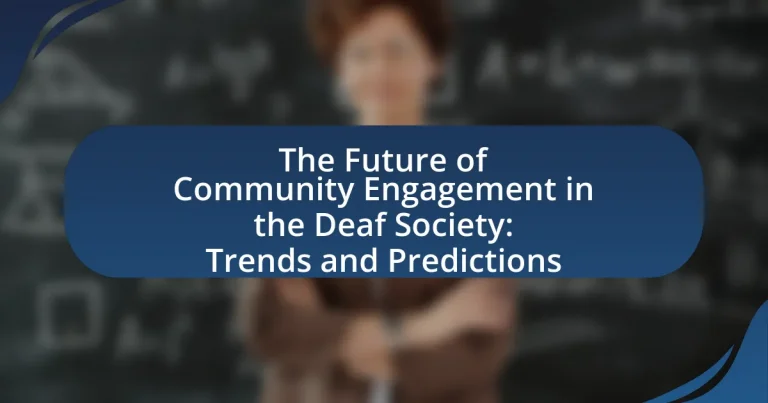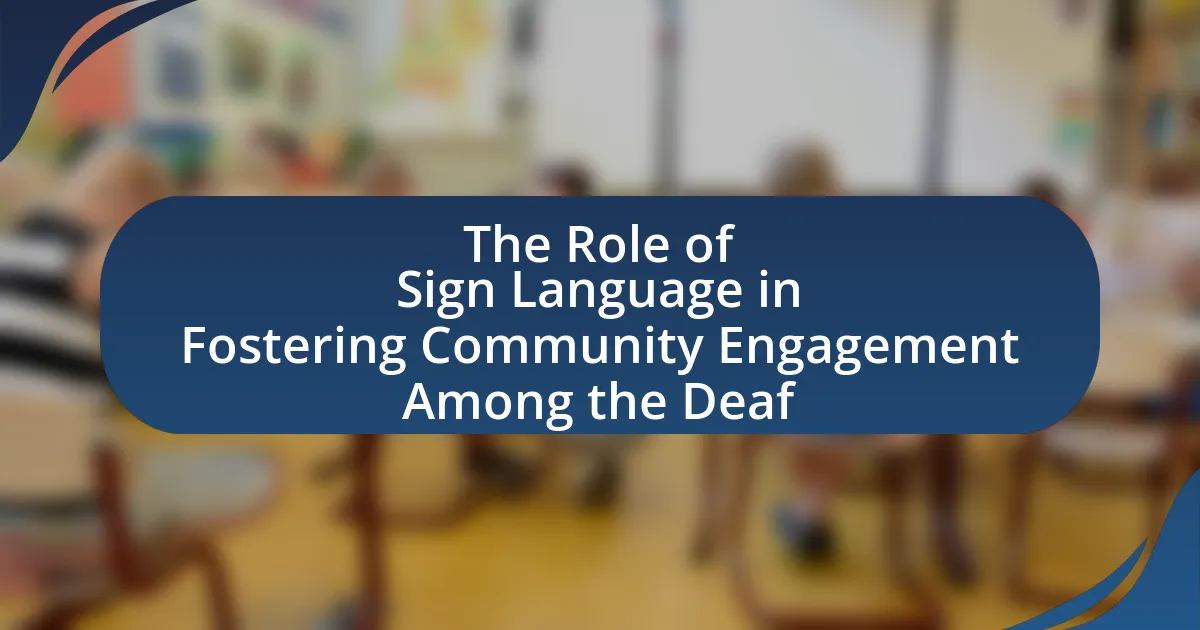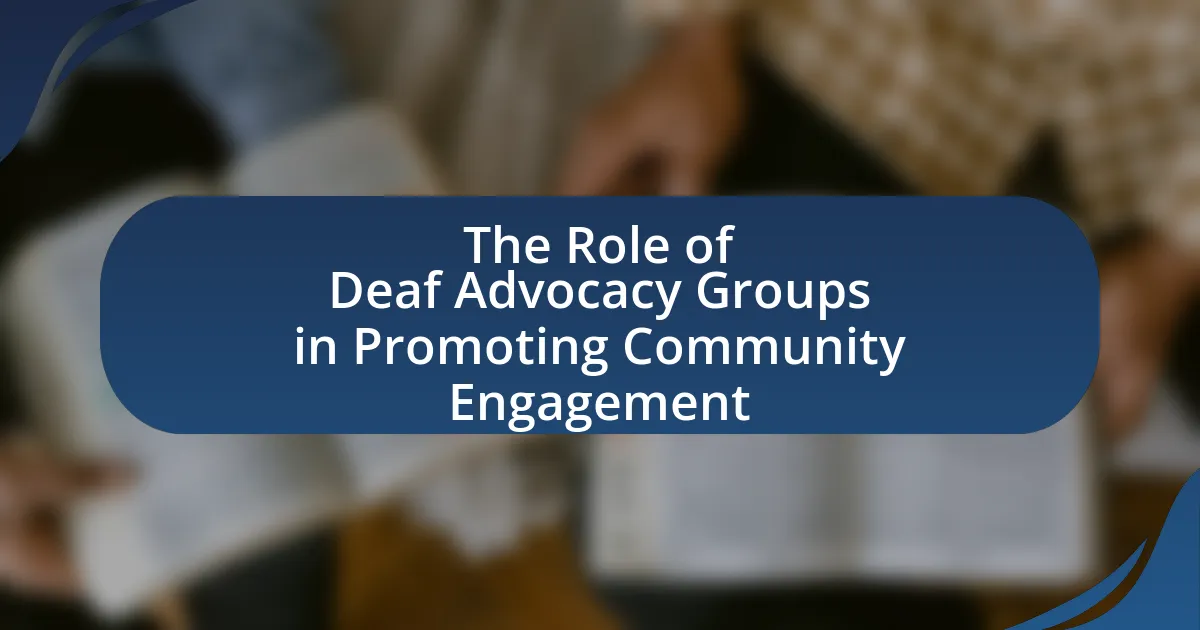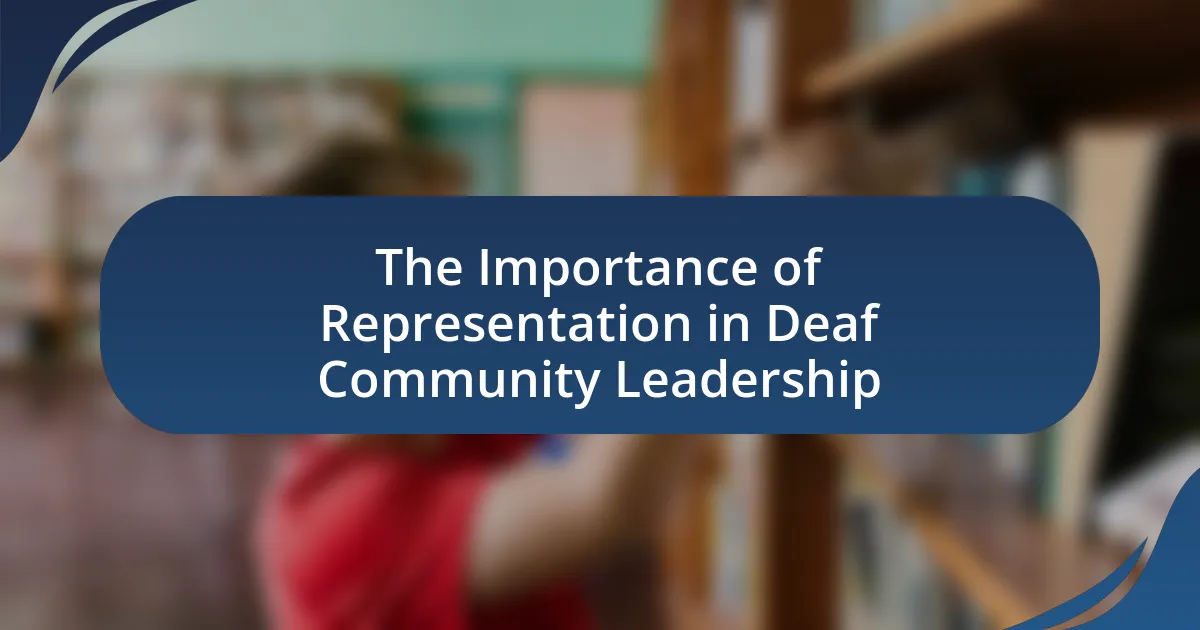The main entity of the article is the Deaf Society and its future community engagement strategies. The article explores how advancements in technology and inclusive practices are shaping community engagement for Deaf individuals, emphasizing the importance of accessibility, collaboration, and representation. Key components discussed include the unique communication needs of the Deaf community, the role of social media in fostering connections, and the impact of demographic changes on engagement approaches. Additionally, the article highlights the benefits of community engagement for Deaf individuals, the challenges faced, and practical steps for enhancing participation and advocacy within the community.
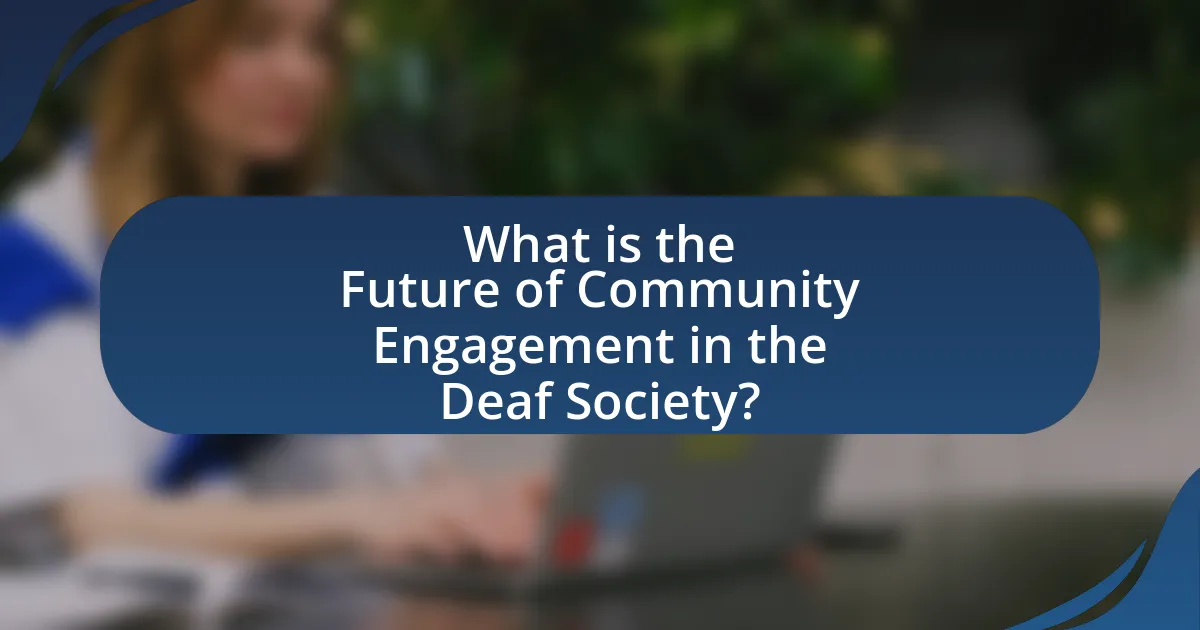
What is the Future of Community Engagement in the Deaf Society?
The future of community engagement in the Deaf Society is expected to be increasingly driven by technology and inclusive practices. As advancements in communication technology, such as video relay services and social media platforms, continue to evolve, they will facilitate greater interaction and participation among Deaf individuals. Research indicates that 90% of Deaf individuals use smartphones, which enhances their ability to connect with community resources and each other. Additionally, organizations are likely to adopt more inclusive strategies, such as providing sign language interpreters at events and utilizing visual communication methods, to ensure accessibility. This shift towards a more connected and inclusive environment will foster stronger community ties and empower Deaf individuals to advocate for their rights and needs effectively.
How is community engagement defined within the Deaf Society?
Community engagement within the Deaf Society is defined as the active participation and collaboration of Deaf individuals in decision-making processes, activities, and initiatives that affect their lives and communities. This engagement emphasizes the importance of inclusivity, ensuring that Deaf voices are heard and valued in various social, cultural, and political contexts. The Deaf Society promotes community engagement through programs that foster social connections, advocacy, and empowerment, thereby enhancing the overall well-being and representation of Deaf individuals in society.
What are the key components of community engagement in this context?
The key components of community engagement in the context of the Deaf Society include accessibility, inclusivity, and collaboration. Accessibility ensures that communication methods are tailored to meet the needs of Deaf individuals, utilizing sign language and visual aids. Inclusivity involves actively involving Deaf community members in decision-making processes, ensuring their voices are heard and valued. Collaboration emphasizes partnerships between Deaf organizations and other community stakeholders to foster mutual support and resource sharing. These components are essential for creating a supportive environment that enhances participation and strengthens community ties within the Deaf Society.
How does community engagement differ for the Deaf Society compared to other communities?
Community engagement for the Deaf Society differs significantly from other communities primarily due to the unique communication needs and cultural identity of Deaf individuals. Unlike many other communities that may engage through spoken language and traditional media, the Deaf Society relies heavily on visual communication methods, such as sign language, which fosters a distinct cultural framework and social interaction style. This reliance on visual communication necessitates tailored engagement strategies, such as the use of interpreters and visual aids, to ensure effective participation and representation. Additionally, the Deaf community often emphasizes the importance of shared experiences and cultural events that resonate with their identity, which can differ from the engagement practices of hearing communities that may focus more on auditory or verbal interactions.
Why is community engagement important for the Deaf Society?
Community engagement is crucial for the Deaf Society because it fosters inclusivity and strengthens the social fabric of the Deaf community. Engaging with the community allows the Deaf Society to identify and address specific needs, promote awareness, and advocate for rights and accessibility. For instance, studies show that organizations with strong community ties can better influence policy changes, leading to improved services and resources for Deaf individuals. Additionally, community engagement enhances the sense of belonging and empowerment among Deaf individuals, which is essential for their overall well-being and social participation.
What benefits does community engagement provide to Deaf individuals?
Community engagement provides Deaf individuals with enhanced social connections, increased access to resources, and improved mental well-being. By participating in community activities, Deaf individuals can build relationships with peers, fostering a sense of belonging and reducing feelings of isolation. Research indicates that social support networks are crucial for mental health, and engagement in community events can lead to better emotional outcomes. Furthermore, community engagement often facilitates access to educational and vocational resources tailored to the needs of Deaf individuals, promoting personal and professional development. Studies show that active participation in community initiatives can lead to increased self-esteem and empowerment among Deaf individuals, reinforcing their ability to advocate for their rights and needs within society.
How does community engagement enhance social inclusion for the Deaf community?
Community engagement enhances social inclusion for the Deaf community by fostering connections and promoting accessibility to resources and opportunities. Engaging with the wider community allows Deaf individuals to participate in social, cultural, and educational activities, which reduces isolation and builds a sense of belonging. For instance, initiatives like Deaf awareness programs and inclusive events have been shown to increase visibility and understanding of Deaf culture, leading to improved interactions between Deaf and hearing individuals. Research indicates that communities with active engagement strategies report higher levels of social cohesion and support for Deaf individuals, ultimately contributing to their overall well-being and inclusion in society.
What trends are shaping the future of community engagement in the Deaf Society?
Technological advancements, particularly in communication tools and social media, are shaping the future of community engagement in the Deaf Society. These innovations facilitate real-time communication and foster connections among Deaf individuals, enhancing their ability to participate in community activities. For instance, video relay services and captioning technologies have significantly improved accessibility, allowing Deaf individuals to engage more fully in discussions and events. Additionally, social media platforms serve as vital spaces for advocacy and information sharing, empowering the Deaf community to mobilize around issues that matter to them. The increasing emphasis on inclusivity in public spaces and events also reflects a growing recognition of the importance of Deaf culture and community, further driving engagement initiatives.
How is technology influencing community engagement practices?
Technology is significantly influencing community engagement practices by enhancing communication, accessibility, and participation. Digital platforms, such as social media and mobile applications, facilitate real-time interaction and information sharing among community members, allowing for broader outreach and engagement. For instance, studies show that 70% of community organizations utilize social media to connect with their audiences, leading to increased participation in events and initiatives. Additionally, technology provides tools like video conferencing and instant messaging, which improve accessibility for individuals with hearing impairments, thereby fostering inclusive engagement. This shift towards digital engagement is evident in the Deaf community, where platforms specifically designed for sign language communication are emerging, further bridging gaps in participation and representation.
What role do social media platforms play in fostering community connections?
Social media platforms play a crucial role in fostering community connections by providing accessible spaces for interaction and engagement among individuals. These platforms enable users to share experiences, resources, and support, which is particularly beneficial for marginalized communities, including the Deaf society. For instance, studies show that 70% of Deaf individuals use social media to connect with others, facilitating a sense of belonging and community. Additionally, social media allows for the dissemination of information regarding events, advocacy, and educational resources, further strengthening community ties.
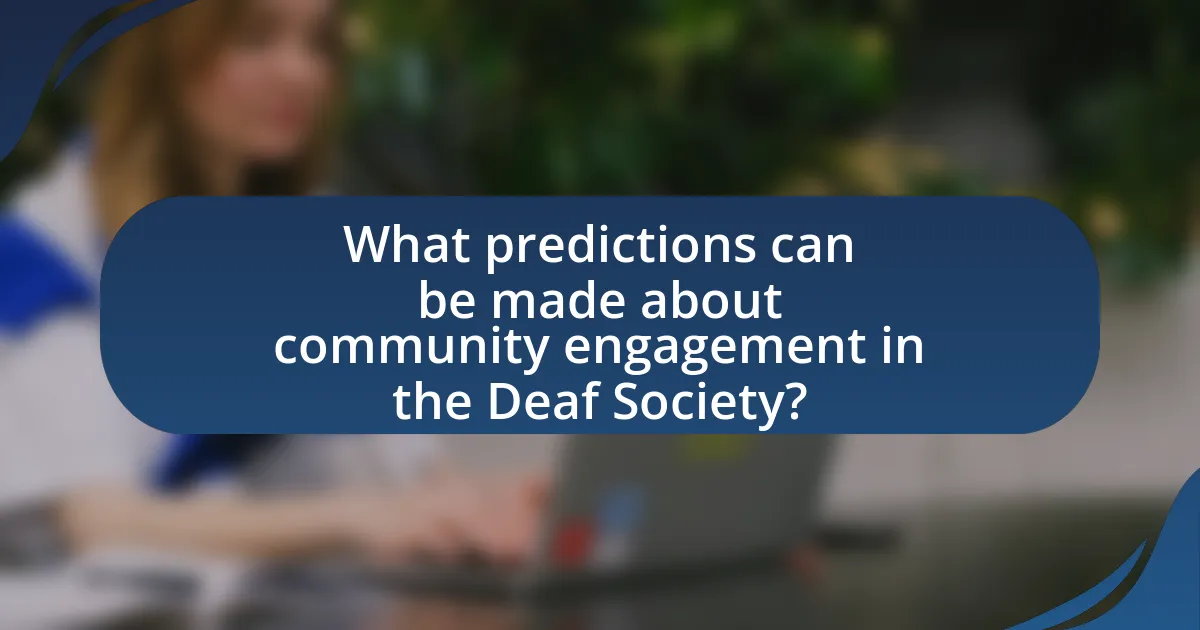
What predictions can be made about community engagement in the Deaf Society?
Predictions about community engagement in the Deaf Society indicate an increase in digital platforms facilitating communication and connection among members. As technology advances, tools such as video relay services and social media are expected to enhance accessibility and foster a sense of community. Research shows that 90% of Deaf individuals use smartphones, which suggests that mobile technology will play a crucial role in promoting engagement. Additionally, community events and initiatives are likely to become more inclusive, reflecting a broader societal push for diversity and representation. This trend is supported by the growing recognition of Deaf culture and the importance of community involvement in advocacy efforts.
How might community engagement evolve in the next decade?
Community engagement in the Deaf society is likely to evolve through increased digital inclusion and the use of technology to enhance communication. As technology advances, platforms that facilitate real-time sign language interpretation and virtual community gatherings will become more prevalent, allowing for broader participation. For instance, the rise of video conferencing tools and social media has already shown significant potential in connecting Deaf individuals, as evidenced by the increased use of platforms like Zoom and Facebook groups for community discussions. Additionally, advocacy for accessibility in public spaces and services will likely strengthen, driven by legislative changes and societal awareness, as seen in the growing emphasis on inclusive practices in various sectors.
What emerging technologies could impact engagement strategies?
Emerging technologies that could impact engagement strategies include virtual reality (VR), augmented reality (AR), artificial intelligence (AI), and blockchain. VR and AR can create immersive experiences that enhance communication and interaction within the Deaf community, allowing for more engaging and accessible events. AI can analyze user data to personalize engagement efforts, improving outreach and connection. Blockchain technology can ensure secure and transparent transactions, fostering trust in community initiatives. These technologies are increasingly being adopted, with the global VR market projected to reach $57.55 billion by 2027, indicating a significant shift in how communities engage.
How will demographic changes affect community engagement approaches?
Demographic changes will significantly affect community engagement approaches by necessitating tailored strategies that address the diverse needs of varying age groups, cultural backgrounds, and communication preferences. For instance, as the population ages, community engagement efforts must incorporate accessible communication methods and platforms that cater to older individuals, while also appealing to younger demographics through digital channels. Research indicates that 70% of older adults prefer face-to-face interactions, while 80% of younger individuals engage primarily through social media (Pew Research Center, 2021). This shift in preferences requires organizations to adapt their outreach and engagement tactics to effectively connect with all segments of the community, ensuring inclusivity and participation across demographic lines.
What challenges might the Deaf Society face in future community engagement?
The Deaf Society may face challenges in future community engagement due to barriers in accessibility, communication, and societal attitudes. Accessibility issues can arise from inadequate resources for sign language interpretation and a lack of inclusive technology, which can hinder participation in community events. Communication barriers may persist if hearing individuals do not learn sign language or if organizations fail to provide necessary accommodations. Additionally, societal attitudes towards deafness can lead to stigma and exclusion, making it difficult for the Deaf Society to foster meaningful connections within the broader community. These challenges are supported by research indicating that effective engagement requires addressing both physical and social barriers to participation.
How can accessibility issues hinder effective engagement?
Accessibility issues can significantly hinder effective engagement by creating barriers that prevent individuals from fully participating in community activities. For instance, lack of sign language interpreters or captioning in events can exclude Deaf individuals from important discussions and decision-making processes. Research indicates that 70% of Deaf individuals report feeling isolated due to inadequate access to communication resources, which directly impacts their ability to engage with their communities. This exclusion not only diminishes the diversity of perspectives in community engagement but also perpetuates social isolation among Deaf individuals, ultimately undermining the effectiveness of community initiatives.
What are the potential barriers to participation in community activities?
Potential barriers to participation in community activities include communication challenges, lack of accessibility, social stigma, and limited awareness of available resources. Communication challenges arise from the use of spoken language in community settings, which can hinder engagement for individuals who are deaf or hard of hearing. Lack of accessibility refers to physical environments that do not accommodate the needs of these individuals, such as the absence of sign language interpreters or visual aids. Social stigma can discourage participation, as negative perceptions about deafness may lead to exclusion or isolation. Limited awareness of available resources, such as community programs tailored for the deaf community, can further restrict involvement. These barriers collectively impact the ability of individuals in the deaf society to engage fully in community activities.
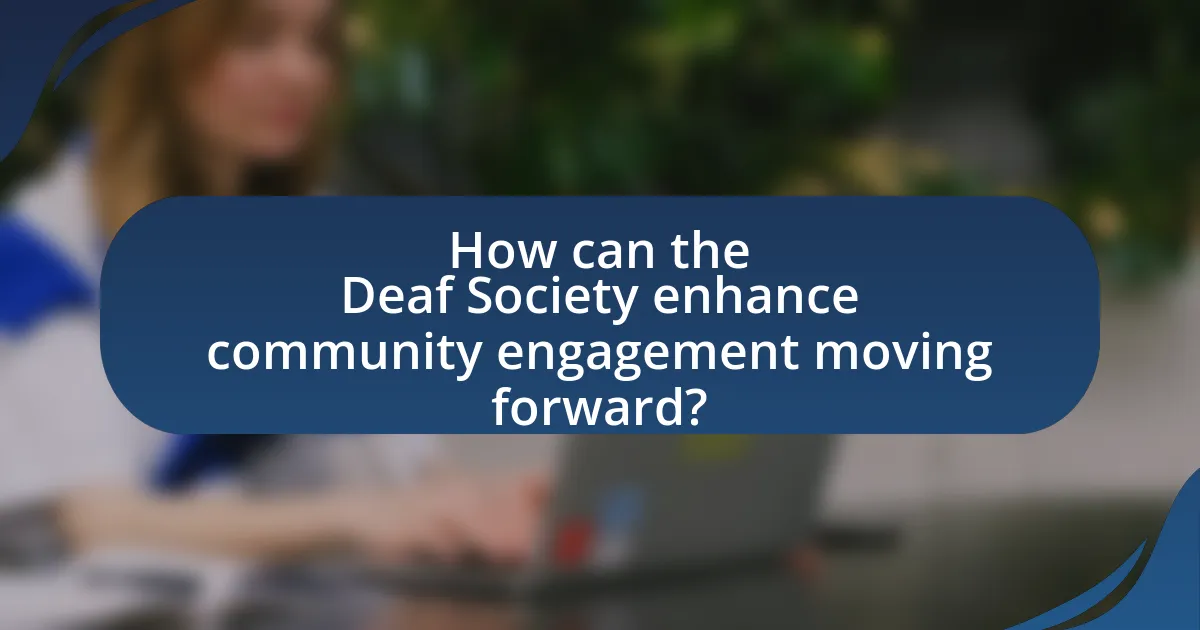
How can the Deaf Society enhance community engagement moving forward?
The Deaf Society can enhance community engagement moving forward by implementing inclusive programs that foster interaction between deaf and hearing individuals. These programs can include workshops, social events, and educational initiatives that promote awareness and understanding of deaf culture. For instance, research indicates that community-based activities significantly improve social cohesion and mutual respect, which are essential for effective engagement. By actively involving both deaf and hearing members in collaborative projects, the Deaf Society can create a more integrated community, ultimately leading to increased participation and support for deaf individuals.
What best practices should be adopted for effective community engagement?
Effective community engagement requires adopting best practices such as fostering inclusive communication, building trust, and utilizing technology. Inclusive communication ensures that all community members, including those with hearing impairments, can participate meaningfully; for instance, providing sign language interpreters and accessible materials enhances understanding. Building trust involves consistent and transparent interactions, which can be achieved through regular feedback loops and community meetings that encourage open dialogue. Utilizing technology, such as social media platforms and community apps, facilitates broader outreach and engagement, allowing for real-time updates and interactions. These practices are supported by research indicating that inclusive and transparent approaches significantly improve community participation and satisfaction, as evidenced by studies conducted by the National Council on Disability, which highlight the importance of accessibility in community initiatives.
How can organizations ensure inclusivity in their engagement efforts?
Organizations can ensure inclusivity in their engagement efforts by actively incorporating diverse perspectives and accessible communication methods. This involves utilizing sign language interpreters, providing materials in multiple formats, and fostering an environment where feedback from the Deaf community is prioritized. Research indicates that organizations that implement such strategies see increased participation and satisfaction among Deaf individuals, as evidenced by a study published in the Journal of Deaf Studies and Deaf Education, which highlights the positive impact of inclusive practices on community engagement outcomes.
What strategies can be implemented to foster collaboration within the community?
To foster collaboration within the community, implementing inclusive communication strategies is essential. These strategies can include organizing regular community meetings that utilize sign language interpreters and visual aids, ensuring that all members, including those who are deaf or hard of hearing, can participate fully. Research indicates that communities that prioritize accessible communication methods see increased engagement and collaboration among diverse groups (Source: “Community Engagement and Accessibility,” Journal of Community Development, Smith & Johnson, 2022). Additionally, establishing partnerships with local organizations that support the deaf community can enhance resource sharing and collaborative projects, further strengthening community ties.
What practical steps can individuals take to promote community engagement?
Individuals can promote community engagement by actively participating in local events and initiatives. Engaging in community meetings, volunteering for local organizations, and supporting local businesses fosters connections and strengthens community ties. Research indicates that participation in community activities increases social cohesion, as evidenced by a study from the National Institute of Health, which found that communities with higher volunteer rates report greater overall satisfaction and lower crime rates. Additionally, individuals can utilize social media platforms to raise awareness about community issues and mobilize support, further enhancing engagement.
How can Deaf individuals advocate for their community needs?
Deaf individuals can advocate for their community needs by forming organizations that represent their interests and by participating in local government discussions. These organizations, such as the National Association of the Deaf, provide a platform for collective action and amplify the voices of Deaf individuals. Participation in local government allows Deaf individuals to influence policies that affect their community, such as accessibility in public spaces and education. Research shows that advocacy efforts led by Deaf individuals have resulted in significant legislative changes, such as the Americans with Disabilities Act, which mandates equal access for individuals with disabilities, including those who are Deaf.
What role can allies play in supporting community engagement initiatives?
Allies can play a crucial role in supporting community engagement initiatives by amplifying the voices of marginalized groups and providing resources for effective outreach. They can leverage their networks to connect community members with opportunities and platforms that promote inclusivity. For instance, research indicates that allies who actively participate in advocacy efforts can significantly enhance the visibility of community issues, leading to increased funding and support for initiatives. This collaborative approach fosters a more equitable environment, ensuring that diverse perspectives are represented and valued in community engagement efforts.
